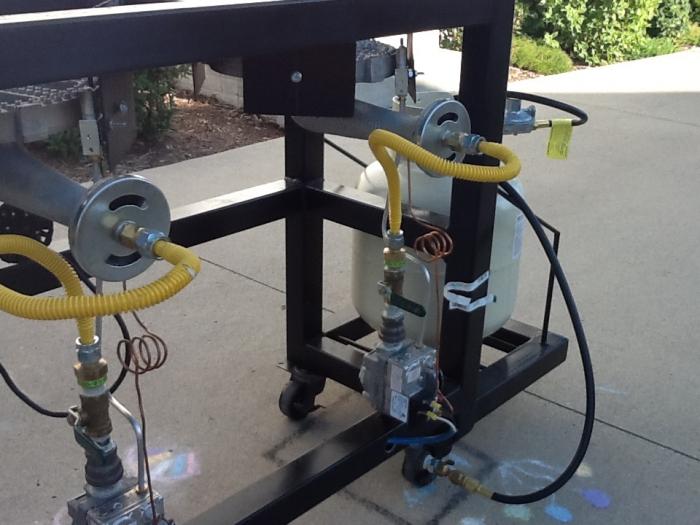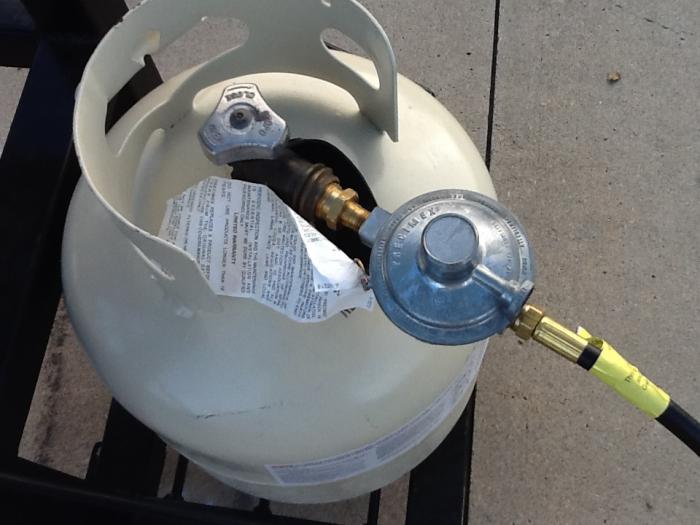Been here, done that. It's a pita. My valves are Honeywell, wished I had gone with a "dumb" valve, but anyways...
I had mini jet burners and the castings failed multiple times, so I went to a banjo burner designed for low pressure (from brewers hardware). I had a heck of a time getting them to burn well for me. Lets not even talk about wind. I went back to mini jets and still had weak flames, but overall significantly improved. Also swapped marshall 290 series two stage regulator to a Reco 450k btu rated on the manifold (1/2" like yours) fed by 3/4" buried line to twin 250gal tanks. Measured pressure on valves and with more than one open I was getting drop in pressure (on the manifold side) with two burners simultaneously, all three was even worse. Very frustrating. Eventually I heeded some advice with great reluctance I finally gave in to the frustrations and bought a welding style regulator. Mine is actually an acetylene regulator. I have aborted the buried tank temporarily and use a portable cylinder now (until I can finish the next mods to the manifold to connect to both the buried cylinders or the portable cylinder, with intent on using the portable cylinder to run the boil kettle for some brews). I found my boil off rate insufficient for boiling off the DMS in brewing 10-11 gallon lager brews, but oddly, worked just fine in doing ales when connected to the buried tanks using that Reco regulator.
What I found was that I could adjust the manifold pressure on the fly with the acetylene regulator connected to the portable tanks. I found that my low pressure mini jet burners like a little higher pressure than the 11" WC that they are supposedly calibrated for. I found that with pressure over 4.5psi that the Honeywell valves wouldn't open and some difficulty getting the pilots to light. 1 psi per active burner seems to work pretty well, though I could run the boil burner at 2-3 psi and it seemed very effective getting the boil rolling. Seems that your high pressure regulator should be able to do the same thing, but the valves may not tolerate as much psi as my Honeywell are able to. Also you don't appear to have a pressure gauge on your manifold or regulator to see what you are running at. Could be that your regulator is not up to snuff. I would consider a welding type regulator. If using an acetylene regulator bothers you they make them for propane as well, just harder to find. I bought my regulator on amazon, its a medium duty Hobart brand I believe. Reverse thread connected directly to the portable cylinder. Another forum member helped me with all the fittings that he had spare from his build, so that I could connect to the manifold on my rig. At this point, what have you got to lose in trying this.
Did have a quickie question. About my buried tanks. As I understand they are coming off the primary tank regulator set at 10 psi through about 25 feet guesstimate of 3/4" piping, to a QD with locking ball-valve connection, that I connect to my brew rig with rubber some flex hose 15'. Right now this is disconnected from my rig, but I plan to connect it back up, and attach on the opposite end of the manifold, another ball valve and then plumb in the new acetylene regulator so that I can do my mash and all that jazz (or even run the boil all off my buried tanks) and reserve the portable tank use for boiling lagers or even just getting the boil started. So the question relates to my Reco regulator, which is an integral or two stage regulator, with 1/4" inlet and 1/2" outlet. . I was wondering since I already have the primary regulator on the buried tanks, if using this two stage regulator is an incorrect application or not.
I find it inexplicable that when I measured pressures on my manifold with this 450k btu rated regulator, that it couldn't maintain 11"WC with two valves open. Somewhere I along the propane pathway there has got to be a restriction. Guy who plumbed the line to the tanks said it was 3/4" Line and certainly looks to be at least 3/4 where is come out of the ground. He knew what my brew rig specs were, and I believe he said it is plumbed to the primary tank regulator set at 10 psi, and I believe is rated to 500k btu minimum ( also connected to generator, grill side burner, two gas fireplaces, pool heater, spa heater, but I believe these appliance all have their own secondary regulators at their installed locations, and usually are not operating while I am brewing). In essence then when I am plugged into the buried tanks, the propane is going through three stages of regulation, and I was curious if that integral / two stage reg on my manifold should really be swapped to a single stage?
TD.






